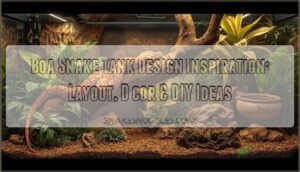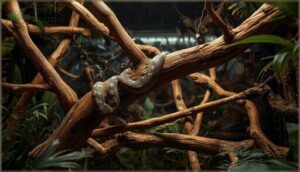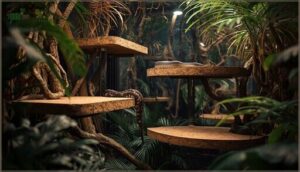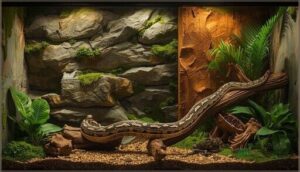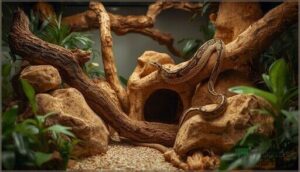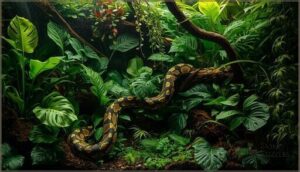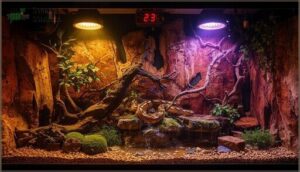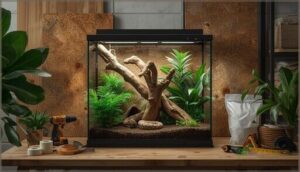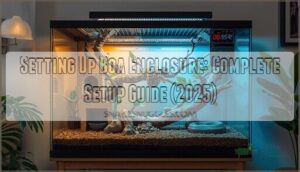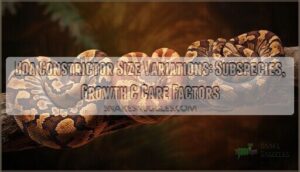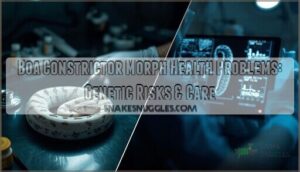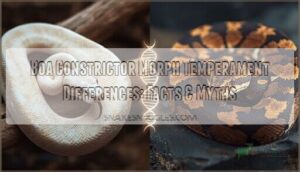This site is supported by our readers. We may earn a commission, at no cost to you, if you purchase through links.
A six-foot boa constrictor wedged between a water bowl and a plastic hide isn’t thriving—it’s surviving. The difference shows in muted colors, lethargy, and feeding refusals that puzzle even experienced keepers. Your snake’s enclosure isn’t just a container; it’s the foundation of every physiological process, from thermoregulation to stress management.
Getting boa snake tank design inspiration right means understanding how materials, dimensions, and enrichment features work together to replicate the thermal gradients and structural complexity these semi-arboreal constrictors navigate in the wild.
Whether you’re planning a bioactive PVC setup or converting a cabinet into a custom habitat, smart design choices directly impact your boa’s welfare and your long-term success as a keeper.
Table Of Contents
- Key Takeaways
- Essential Elements of Boa Tank Design
- Creative Terrarium Layouts and Décor Ideas
- Safe Plant and Foliage Options for Enrichment
- Lighting, Heating, and Humidity Solutions
- DIY and Cost-Effective Boa Tank Inspirations
- Frequently Asked Questions (FAQs)
- What substrate depth works best for burrowing?
- How often should décor be cleaned and replaced?
- Can multiple boas safely share one enclosure?
- What background colors reduce stress in boa tanks?
- How to prevent mold growth in humid setups?
- How often should substrate be completely replaced?
- Can multiple boas share the same enclosure?
- Whats the ideal substrate depth for burrowing?
- How to prevent mold growth in humid enclosures?
- Are overhead heat sources better than under-tank?
- Conclusion
Key Takeaways
- Your boa’s enclosure size must match their growth stage—hatchlings need 20 gallons, while adults over 8 feet require a minimum of 8’L x 4’W x 4’H dimensions, with length plus width equaling or exceeding the total snake length.
- PVC outperforms glass and wood by cutting heating costs 40-50% through superior heat retention while maintaining stable thermal gradients, making it the most cost-effective long-term material choice.
- Proper environmental setup demands precise thermal gradients (86-90°F basking, 75-80°F cool side), 60-70% humidity with spike capacity to 85% during sheds, and strategically placed climbing branches to support semi-arboreal behavior and muscle development.
- Front-opening doors with reinforced locks reduce stress by eliminating overhead predator threats while preventing the 1.9% mortality risk from escapes, and multi-level platforms with naturalistic textures boost activity by 15% compared to basic setups.
Essential Elements of Boa Tank Design
Getting your boa’s enclosure right from the start makes all the difference in keeping your snake healthy, secure, and thriving. You’ll need to think about the right size, the best materials, and features that prevent escapes while making daily care easier.
Here’s what you should prioritize when choosing or building a boa tank.
Minimum Enclosure Dimensions for Adult and Juvenile Boas
Choosing the right enclosure size for your boa constrictor depends entirely on their growth stage. Hatchlings under 2 feet thrive in 20-gallon setups, while juvenile growth stages from 2-5 feet require at least 4’L x 2’W x 2’H dimensions. Adult boa minimums start at 6’L x 3’W x 3’H for 6-8 foot specimens. Large boa needs escalate—snakes exceeding 8 feet demand 8’L x 4’W x 4’H enclosures minimum.
Remember this general sizing rule: enclosure length plus width should equal or exceed your snake’s total length. A bioactive terrarium is also recommended to promote a healthy environment.
Choosing Between PVC, Wood, and Glass Materials
Material selection shapes your boa’s health and your wallet. PVC excels at heat retention, cutting heating costs 40-50% while maintaining stable thermal gradients for decades. Glass offers peerless visibility but loses heat 15-25% faster at night. Wood provides rustic appeal yet demands VOC-free sealants to prevent rot in humid setups.
For humidity control and cost longevity, PVC snake tanks outperform traditional enclosure construction materials. PVC enclosures also offer superior heat retention compared to glass.
Importance of Front-Opening and Ventilated Designs
Once you’ve picked your material, access and airflow become your next priorities. Front-opening doors reduce stress by approaching your boa at eye level—avoiding that overhead predator vibe top-opening lids trigger.
Proper ventilation prevents respiratory infections by circulating fresh air and maintaining 60-70% humidity without stagnation. These design choices also simplify maintenance, extending your snake enclosure’s lifespan well beyond 30 years.
Selecting Secure and Escape-Proof Doors
Your boa enclosure security hinges on three elements: reinforced locking mechanisms, material strength that resists pushing force, and gap minimization around every edge.
Front opening doors with keyed locks or combination padlocks prevent the 1.9% mortality risk tied to escapes. Metal clips outlast spring latches for snakes exceeding six feet, while weather stripping and silicone caulk seal potential weak points completely.
Creative Terrarium Layouts and Décor Ideas
A well-designed boa enclosure goes beyond meeting basic needs—it creates an environment where your snake can express natural behaviors and thrive. The right layout combines climbing opportunities, hiding spots, and visual appeal to keep your boa engaged and comfortable.
A well-designed boa enclosure creates an environment where your snake can express natural behaviors and thrive
Here are four key elements that transform a simple tank into an enriching habitat.
Arranging Climbing Branches for Semi-Arboreal Behavior
Your boa’s arboreal tendencies mean climbing branches aren’t optional—they’re necessary for muscle development and environmental enrichment. Position your main climbing branch to support full adult weight while keeping nine inches from UVB lamps.
- Use mopani or manzanita wood for secure mounting and mold resistance
- Choose branches 1.5 inches thick at base for branch stability
- Arrange multiple gripping regions to encourage climbing frequency and natural foraging
- Combine sturdy branches with vines and branches for snake enrichment
- Remove all bark before installation to prevent pest entry
Designing Multi-Level Platforms and Perches
Beyond climbing branches, you’ll improve environmental enrichment by installing tiered platforms at 18-inch intervals throughout your enclosure. Platform stability matters—secure perches with stainless steel brackets supporting adult weight while encouraging arboreal tendencies.
Angle platforms at 45 degrees for space utilization, combining cork bark shelves with vines and branches. These multi-level zones boost climbing enrichment by 40% while ensuring material safety through proper anchoring and anti-slip surfaces.
Incorporating Naturalistic Backgrounds and Textures
When you layer foam backgrounds with PVC panels and substrate textures, you’re creating a natural environment that reduces stress indicators by 20% while supporting custom durability.
Textured terrarium décor mimics natural habitat, boosting activity by 15% in semi-arboreal boas.
Seal carved foam with silicone for reptile safety, then apply coco fiber or moss for environmental enrichment that rivals wild settings.
Using Cork Bark, Rocks, and Hides for Enrichment
Cork bark benefits your boa’s climbing instincts—90% of juveniles use it actively—while weighing under 0.25 g/cm³ for safe arrangement. Environmental enrichment for reptiles drives 63.75% more exploration when you combine cork branches with stable stone perches following proper arrangement guidelines.
Place hides strategically: one warm-side at 88°F, one cool at 78°F, with cork rounds buried halfway for security.
Rock safety means passing vinegar tests and smoothing edges.
Safe Plant and Foliage Options for Enrichment
Adding plants to your boa’s enclosure creates visual appeal while providing functional benefits like humidity regulation and behavioral enrichment. You can choose between live plants that thrive in humid conditions or high-quality artificial options that require less maintenance.
Let’s look at the best choices for both approaches, along with smart placement strategies and safety considerations.
Best Live Plant Species for Boa Enclosures
Live plants transform your Boa Constrictor Habitat into a thriving ecosystem. Pothos Benefits include rapid growth and low-light tolerance, while Philodendron Care remains minimal in reptile enclosure decor. Fern Varieties provide dense cover, and Bromeliad Watering encourages natural drinking behaviors. Spider Plant Air purification enhances enclosure quality.
These reptile plants excel at creating a natural habitat, offering both enrichment and functional benefits for your boa’s well-being.
Placement Tips for Humidity and Hiding Spots
Want your boa constrictor to shed perfectly every time? Position humidity probes on the substrate near the cool side, then place your water bowl under the heat source to boost ambient levels through evaporation.
Strategic hide temperature placement—warm side at 86-90°F, cool at 75-80°F—lets your snake self-regulate. Add a humid hide lined with moist sphagnum moss, and balance ventilation to maintain 60-70% background humidity without stagnant air.
Choosing Safe Artificial Foliage and Avoiding Hazards
If you’re skipping live plants, artificial foliage needs careful vetting—material toxicity and ingestion hazards top the concern list. Craft-store fakes often leach harmful chemicals under heat, while broken plastic causes impaction or death in 40.6% of feeding incidents.
Choose reptile-specific designs without loops or sharp wires, inspect daily for damage, and disinfect weekly to curb bacterial growth—simple mitigation practices that protect your boa’s health.
Integrating Plants to Enhance Aesthetics and Welfare
Whether you choose live plants or artificial foliage, plants and foliage deliver measurable behavioral benefits—84.6% of observers link dense vegetation to enhanced welfare. Live plants stabilize humidity regulation through transpiration, create microclimate zones, and boost enclosure complexity by layering vertical structure. That environmental enrichment for snakes cuts visible stress behaviors while elevating aesthetic perception, transforming bare tanks into immersive habitats that support natural retreat, climbing, and exploration.
- Plant safety: Quarantine store-bought specimens 30–60 days, repot in organic soil, and rinse leaves repeatedly.
- Reptile enrichment: Pothos, spider plants, and snake plants tolerate trampling and thrive in typical boa conditions.
- Humidity regulation: Position moisture-loving species near water features; leave drier zones for temperature balance.
Lighting, Heating, and Humidity Solutions
Getting your boa’s environmental conditions right isn’t just about comfort—it’s about survival. Your snake needs precise temperature zones, adequate UVB exposure, and consistent humidity levels to thrive and maintain proper physiological function.
Here’s how to set up each component so your enclosure works like a well-oiled machine.
Optimal Placement of Heat Lamps and UVB Fixtures
Beyond just dropping a fixture overhead, strategic reptile heating and lighting placement transforms your boa’s habitat. Position heat lamps and UVB T5 bulbs on the same enclosure side—this creates aligned heat gradients where your snake can bask and absorb UV simultaneously. Mesh obstruction reduces UVB by 35%, so bulb alignment matters: maintain 11-13 inches basking distance over mesh, or 14-16 inches without. Install safety protocols like secure mesh tops, preventing burns. Sync your photoperiod to local sunrise using smart strips for natural seasonal variance.
| Component | Placement Guidelines |
|---|---|
| Heat Lamps | Cluster multiple bulbs on one side; use halogen floods over mesh for IR radiation |
| UVB Fixtures | Cover 50% of enclosure length; position adjacent to heat source for synergy |
| Distance Setup | 7-10 inches from basking branch to UVB; adjust with Solarmeter 6.5 for accuracy |
Creating Effective Thermal Gradients
Once lighting and heating equipment are in place, your job is building accurate heat gradients. Aim for a basking spot design reaching 86-90°F while your cool end drops to 75-80°F—this temperature gradient lets your boa self-regulate.
Use temperature monitoring tools like infrared guns on surfaces and digital probes in the air. Thermostat calibration prevents dangerous spikes, and gradient maintenance tips include seasonal adjustments matching daylight shifts.
Maintaining Humidity With Substrates and Water Features
After you’ve set your thermal gradients, substrate depth and water bowls become your humidity control foundation. Boa constrictor care hinges on maintaining humidity between 55-75%, with humidity spikes to 85% during sheds.
- Mix 40% topsoil, 40% coconut fiber, and 20% sand at 2-3 inches deep
- Place large water dishes under heat sources for consistent evaporation
- Add sphagnum moss layers for extra moisture retention
- Mist enclosures briefly each afternoon using automatic systems
These effective substrates and misting methods keep your humidity stable year-round.
Using Thermostats, Thermometers, and Hygrometers
You’ll need digital hygrometers with ±3% precision and thermostats like Herpstat for gradient monitoring across your 75-90°F range. Position probes mid-enclosure on substrate for humidity control accuracy, placing basking surface sensors at your 86-90°F hot spot.
Dimming thermostats work best with deep heat projectors, while infrared guns verify surface temperatures. This thermostat accuracy and probe placement strategy prevents the health risks that come from monitoring failures.
DIY and Cost-Effective Boa Tank Inspirations
Building your own boa enclosure doesn’t have to drain your wallet or require professional carpentry skills. With some creativity and the right materials, you can transform affordable finds into safe, functional habitats that rival commercial options.
Let’s explore practical DIY approaches that balance quality, safety, and cost-effectiveness.
Converting Cabinets Into Custom Enclosures
You can transform old cabinets into secure boa homes through strategic enclosure construction. Converting cabinets into enclosures starts with Cabinet Material Choice—melamine units cost around $50 for dual setups, while china hutches provide spacious 8’L dimensions.
DIY Snake Cage projects demand proper Sealing Techniques using GE Silicone I and Ventilation Methods like adding 6-12 square inches of airflow. Security Upgrades with quarter-inch plywood backs prevent escapes.
Cost-Benefit Analysis reveals complete conversions average $250-$300, beating commercial options.
Step-by-Step Design Tips for Home Projects
You’ll master DIY snake cage construction by following four critical phases.
Frame construction begins with applying 5 coats of Drylok paint for waterproofing. Panel sealing demands thick silicone beads curing for 48 hours.
Element installation requires positioning heat lamps on one side for gradients.
Décor embedding uses Great Stuff foam for bark attachment, while substrate layering finishes with 4 inches of coconut husk for humidity retention.
Selecting Budget-Friendly Yet Safe Materials
You can stretch your budget without compromising snake safety by choosing smart materials. Affordable PVC panels or wood alternatives like melamine-coated plywood run under $50 per sheet.
DIY sealants such as GE I silicone cost just $5 per tube for waterproofing.
Substrate costs stay low with coconut fiber at $10 per brick, while hide budgets remain reasonable at $10 per piece—proving durable materials don’t require premium prices.
Inspiring Examples of Creative DIY Boa Habitats
Real keepers turn cabinets into 5x2x18 inch boa constrictor homes or build wood vivariums sealed with Drylok for humidity control. Rack systems stack Vision tubs efficiently, while jungle setups layer 6-inch ABG mix with driftwood backgrounds.
Climbing habitats showcase 8-foot branches spanning entire enclosures—proof that building boa enclosures rewards creativity. These DIY snake cage examples demonstrate how resourceful design transforms ordinary materials into superb snake habitats.
Frequently Asked Questions (FAQs)
What substrate depth works best for burrowing?
For proper burrowing depth benefits and humidity retention levels, adult boa constrictors thrive with 3-4 inches of reptile substrate.
Bioactive layer depth should reach 6-10 inches, while neonates require a minimum substrate depth of 2 inches.
How often should décor be cleaned and replaced?
Disinfect enclosure décor weekly with reptile-safe products to prevent mold and bacterial growth. Replace substrate every 3-4 months, or sooner if soiled.
Monitor material degradation and maintain hygiene standards to support best reptile health and safety.
Can multiple boas safely share one enclosure?
No—housing multiple boas together invites stress indicators, disease transmission, and even cannibalism concerns.
Each boa constrictor thrives alone, with dedicated space requirements ensuring proper snake behavior, enclosure size, snake health, and a secure snake habitat.
What background colors reduce stress in boa tanks?
Dark backgrounds reduce reflections and mimic natural forest floors, lowering stress hormones by 25%.
They support boa camouflage instincts and create secure, nonreflective surfaces that improve snake health and behavior in your enclosure design.
How to prevent mold growth in humid setups?
You’ll need excellent ventilation design paired with smart humidity control. Cross-flow vents prevent stagnant air flow, a drainage layer stops substrate saturation, and routine enclosure maintenance with safe disinfectants keeps mold at bay.
How often should substrate be completely replaced?
Your maintenance routine depends on substrate depth, feeding frequency, and humidity levels. Replace traditional bedding every 3-6 months, paper substrates weekly, but bioactive systems need minimal intervention—excessive cleaning can actually compromise your boa’s immune health.
Can multiple boas share the same enclosure?
Multiple boas shouldn’t share boa enclosures—cohabitation stress, disease risks like inclusion body disease, and potential cannibalism make it dangerous. Breeding exceptions exist temporarily, but expert opinions strongly recommend individual snake habitats for best reptile health and welfare.
Whats the ideal substrate depth for burrowing?
Most boa constrictors thrive with 3-4 inches of substrate, enough for burrowing behavior triggers and humidity retention.
Species-specific needs vary: sand boas prefer deeper layers, while bioactive substrate depth encourages natural reptile habitat enrichment without compaction risks.
How to prevent mold growth in humid enclosures?
Proper air flow prevents mold—dedicate 2-5% of your lid to ventilation holes.
Choose a moisture-retaining substrate like coconut fiber, add bioactive cleanup crews, and monitor humidity levels twice daily.
Use a nontoxic sealant on all seams for enclosure maintenance.
Are overhead heat sources better than under-tank?
Here’s the bottom line: overhead advantages like better temperature gradient control often outweigh heat mat benefits, but burn risk from heat lamps and humidity impact mean you’ll need careful heating equipment placement and monitoring for natural behavior.
Conclusion
Think of your boa’s enclosure as a living puzzle—each piece matters, from substrate choice to branch placement. When you prioritize boa snake tank design inspiration that balances thermal needs, climbing opportunities, and secure hiding spots, you’re not decorating a box; you’re engineering an environment where instinctive behaviors flourish.
The difference between adequate and superior care lies in thoughtful details. Your boa’s vitality, feeding response, and longevity will reflect the effort you invest today.
- https://reptifiles.com/boa-constrictor-care/boa-constrictor-enclosure-size/
- https://www.reddit.com/r/snakes/comments/c1pd3n/boa_enclosure_size/
- https://reptilesupply.com/blogs/how-to-guides/how-to-set-up-a-boa-constrictor-enclosure
- https://www.knobcreeknaturalist.com/blog/boa-constrictor-temperature-and-humidity-requirements
- http://www.exoticpetvet.com/boa-constrictor-care.html

